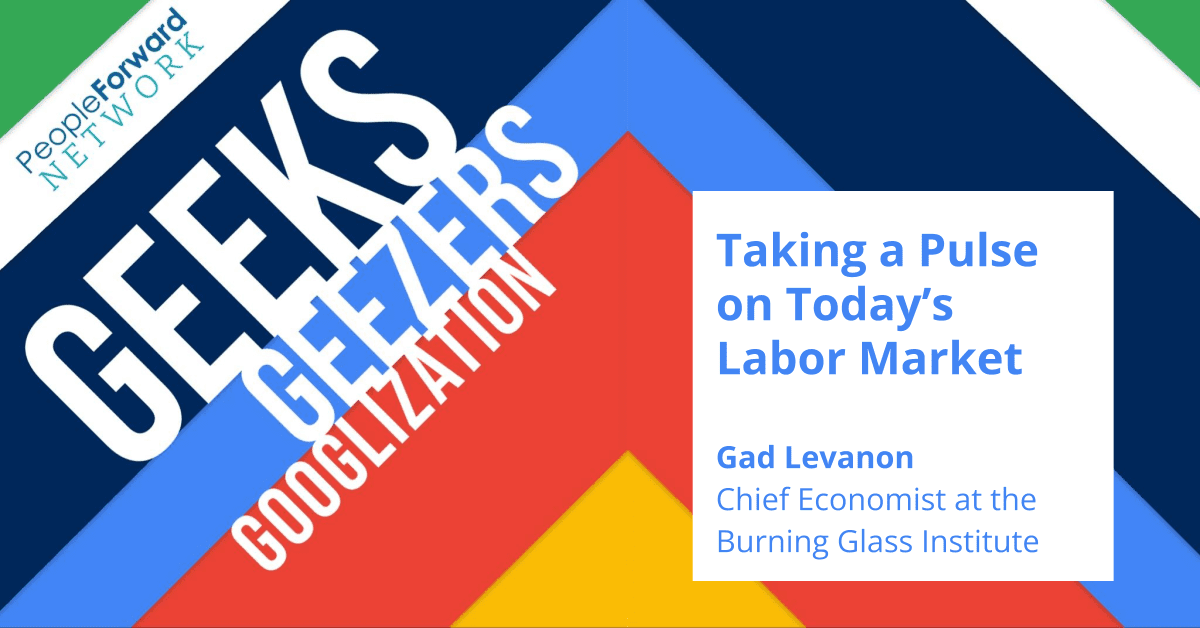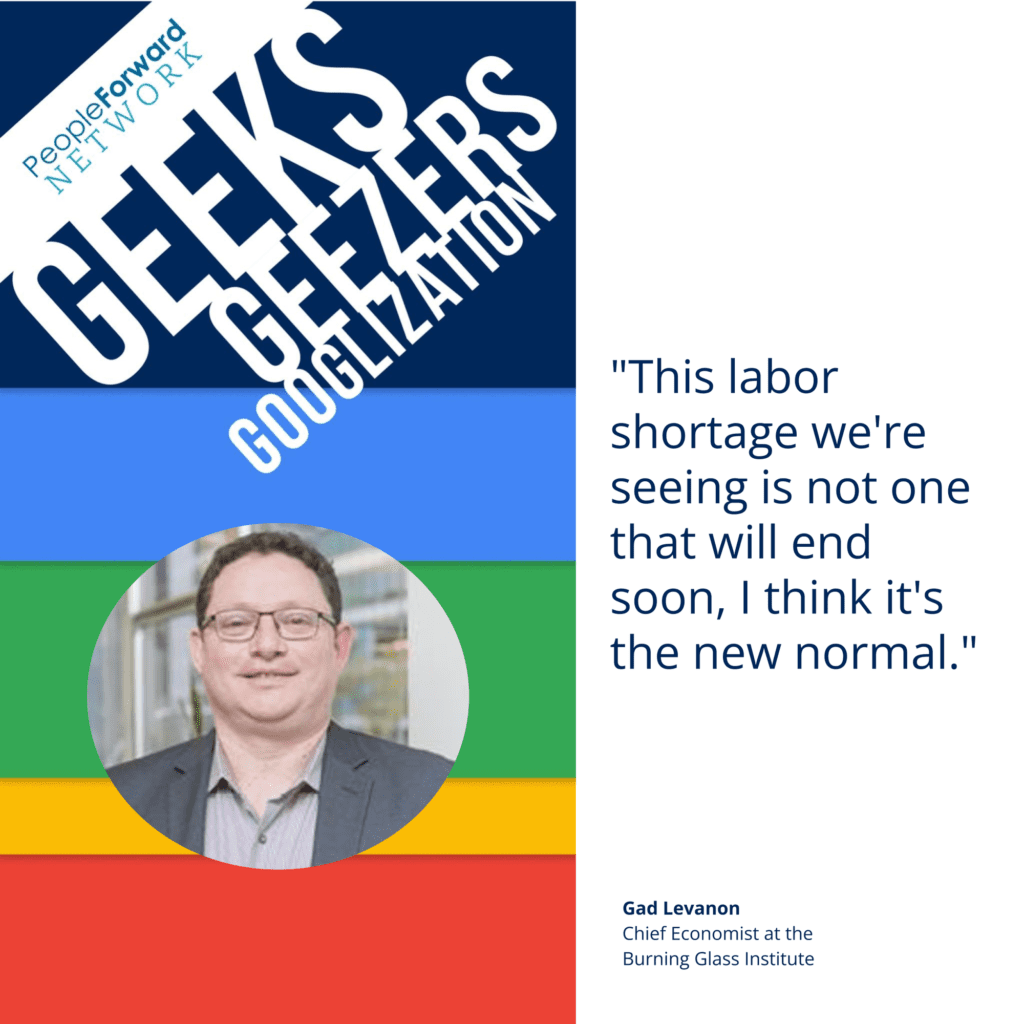
“We are now experiencing two, once-in-a-century trends happening at the same time—the labor shortage is one and the shift to remote work is the other.”
Gad Levanon, Chief Economist at the Burning Glass Institute, has won awards for accurately forecasting U.S. economic trends. In this episode of Geeks, Geezers, Googlization, Gad joins hosts Ira Wolfe and Jason Cochran to break down the numbers behind the labor shortage, discuss ways businesses are adapting to keep filling job openings, and his take on the shift to remote work. These trends are dramatically disrupting labor and economic playbooks.
In this episode, you’ll learn:
The shift to remote work is changing the labor market in ways we have yet to realize.
Labor shortages aren’t new and they aren’t going away.
Automation isn’t evil, it can offset the labor shortage and create more jobs.
Who Is Gad Levanon
Levanon joins Geeks, Geezers, Googlization fresh off of the heels of joining the non-profit Burning Glass Institute, an industry leader in studies and data predicting the labor market. Prior to this he left a distinguished career of 18 years at The Conference Board, where he founded The Labor Market Institute. His research is focused on trends in the US and globally. From a very early age Levanon expressed a love of data, which is a “a very good combination in the economics field” (Levanon, 00:07:59). What’s his take on the shift to remote work? It’s dramatically changing the labor and economic playing field.
Where Have All The Workers Gone?
With 11 million open jobs and 8 million applicants, host Ira S Wolfe feels it is important to understand what happened to all the workers. While the labor shortage was accelerated during the pandemic, the trend was evolving long before the pandemic, Levanon tells the Geeks, Geezers, Googlization audience. Lavanon shares key points to what may bring an end to the labor shortage.

A lot of young men are living with their parents: “30 percent of men aged 25-34 without a BA are living at home with their parents.” (Levanon, 00:11:11) These men are less desperate to work because they have fewer bills to pay.
For the past few decades, there has been a large increase in the number of people who are not counted in the labor force due to disability. In part this is created by “a deterioration in health conditions of people, a lot of it is related to drug addiction and mental health.” (Levanon, 00:12:00) These factors remove a lot of qualified people who are willing and able to work.
Levanon draws attention to Baby Boomer retirements, another key factor in the decline of labor force participation. A significant reason why businesses can’t hire enough workers is simply because millions of Baby Boomers left the workforce due to retirement.
Wolfe noted significant participation rate differences between ethnic, socio-economic, and gender cohorts: “it impacts the Hispanic and the black cohorts since they generally don’t get higher education.” (Wolfe, 00:13:41) This racial disparity was only exaggerated once the pandemic hit, notes Levanon. Another factor is fear. Many parents, especially women, dropped out of the labor force to take care of their kids during school closures. And a generation of laborers opted to become more selective about where and how they worked during, and now after, the pandemic.
Short Term Labor Solutions
Levanon believes a good short term solution to labor shortages is immigration: “the best way to add workers to an economy would be to have larger immigration, I think it could be a short term solution but it’s probably never going to happen. Immigration is a very controversial topic.” (Levanon, 00:16:20) One benefit of low immigration and the pandemic was that some companies started hiring more unconventional workers, such as Hispanic women who experienced a higher participation rate. In general, women were hired for jobs they don’t traditionally do. Another trend is that many companies have lowered education requirements. Levanon says the most straightforward way for a company to solve labor shortages is to raise pay.
Industries Getting Hit The Hardest
The long term picture of Levanon’s research reveals labor shortages in the future will typically impact blue collar and manual service jobs. This is the exact opposite trend from decades in the post World War era. “The number of the people in the working age without a BA is shrinking rapidly and that’s because a larger share of young people have a BA now compared to the share of people about to retire.” (Levanon, 00:20:53) The number one industry at risk for continued labor shortages now and in the future is healthcare. While it has strong growth and high demand, many of its workers are older and will retire in the coming years. Many jobs in healthcare also don’t have the option to work remotely.
An End In Sight For The Labor Market
Levanon emphasized that he is not an epidemiologist but an economist. But he does believe the most destructive part of the pandemic is behind us due to vaccinations and improvements in treatment. Subsequently, service industries are expected to have a strong recovery in 2022. This will only exaggerate labor shortages. The good news is those who were hesitant to work because of the COVID19 pandemic will slowly return to the labor market.
Automation And The Labor Shortagead
Levanon does believe the potential for automation could be the number one offset for the labor shortage. Entering the pandemic, Levanon was not optimistic, because contrary to popular opinion, the previous decade experienced the least progress in automation in US history. But the unexpected shift to remote work during the pandemic will definitely require an exponential spurt in automation. The digital transformation of companies, consumers, and households will accelerate the adoption of automation.
The Automation Slow Down
It’s not that automation is disappearing or replacing workers with technology is no longer a problem, admits Levanon. But compared to the 1990s and 2000s we experienced almost no labor productivity growth in manufacturing or office administrative jobs. Both industries saw tremendous job loss up until 2010 but have dropped off since then. Wolfe noted that it is important to recognize “there was a lot of automation but it also created new jobs and new opportunities.” (Wolfe, 00:35:54). Levanon agreed and highlights that a lot of the innovation in the past decade was not a job killer but job improver.
How Reliable is The Unemployment Rate As A Predictor
The unemployment rate is not a great predictor of the labor market or where it is going, according to Levanon. A key example of how the unemployment rate can mislead: “In the beginning of the current labor shortage, around April, May and June, the unemployment rate was still elevated but the labor market was extremely tight.” (Wolfe, 00:39:55). This was because a lot of the people who were counted as unemployed didn’t seriously look for a job due to the reasons mentioned above. Levanon says resources from organizations like the NFIB (National Federation of Independent Business), along with state and U.S. governments, produce excellent monthly surveys about jobs and the labor market.
